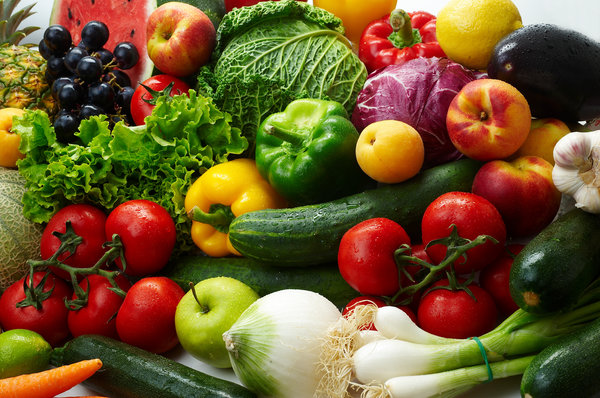
Keeping a healthy diet and taking care of your body requires you to eat a lot of fruits and vegetables that are full of vitamins, minerals and nutrients. To get the best out of produce you must go through the process of selecting the best of the bunch. Here are 17 tricks that will help in selecting the best fruits and vegetables.
Getting Fresh Produce
According to an article published by Clemson.edu, today’s technology allows supermarkets to get fresh produce, just a day or two after it has been picked. The best way to find out when fresh produce has arrived at the market is to give them a call. This way, you can head out to purchase your goods as soon as they arrive.
Choosing the Best Quality Produce
Just because a fruit or veggie doesn’t look exactly how they appear on commercials or magazines, doesn’t mean it’s gone bad. Bananas, for example, have the best taste when they have a few speckles. Get to know your fruits and veggies and when they are best to eat. This will help you easily point out the ripest ones.
Use Your Sense of Smell and Touch
One of the easiest ways to tell if a fruit or vegetable is ripe is to feel them. Many fruits and vegetables, including apples, peaches, oranges, mangoes, zucchinis and squash, will be tender to the touch. Meanwhile, other fruits display ripeness through smell. Melons, for instance, exude a strong scent when they’re ready to be eaten.
Check out this guide from the University of Tennessee on what to look for when choosing fruits and vegetables.
Check for the Grade
Selected fruits and vegetables have a grade designated by the United States Department of Agriculture (USDA), which is displayed by a sticker on the fruit itself. Some of these include apples, onions and potatoes. Look for labels that say, “U.S. No 1,” the most common designation, and “U.S. Fancy,” which is the highest grade. If it goes below No. 1, it is of a lower quality produce.
Find the Local Produce
Because it goes through less handling and travel, local produce tend to be fresher and have better taste. Just like your grocer can tell you when their freshest fruits and vegetables are available, they can also tell you what locally produce they carry.
Check Out Your Farmer’s Market
You can find a wide variety of local produce that’s in season at your local farmer’s markets. Most cities have farmer’s markets that take the weekends, making it a fun and convenient way to learn more about your local produce. Farmer’s markets can sometimes be less expensive than traditional supermarkets.
If you’d like to find out where you can find your local farmer’s market, check out the USDA website.
Check Out the Stands
Many farmers and produce growers will have stands close to their homes selling their produce. These fruits and vegetables are usually sold within hours of being picked, making them some of the freshest options you can get. Your local county Extension agent can direct you to local fruit and vegetable stands.
Shop for Produce in Season
Produce that is grown during a particular season will always be the freshest. It’s typically less expensive, too. Here’s a list of produce by the season courtesy of Clemson.edu.
- Summer: apricots, blueberries, cherries, eggplant, fresh herbs, green beans, hot peppers, melon, okra, peaches, plums, sweet corn, sweet peppers, tomatoes, zucchini
- Fall: apples, broccoli, Brussels sprouts, cauliflower, collards, grapes, kale, pears, persimmons, pumpkins, winter squash, yams
- Winter: beets, cabbage, carrots, citrus fruits, daikon radishes, onions, rutabagas, turnips, winter squash
- Spring: asparagus, blackberries, green onions, leeks, lettuces, new potatoes, peas, red radishes, rhubarb, spinach, strawberries, watercress
Check for Wax Coating
Some fruits or vegetables already come with a natural wax, which helps them keep their moisture. During the washing process, many fruits or vegetables lose their natural wax, so they are sometimes given a wax coating during packaging with the intention on retaining moisture, protecting the skin from bruising and to enhance appearance. The FDA suggests looking for stickers that say, “Coated with food-grade vegetable-, petroleum-, beeswax-, or shellac-based wax or resin, to maintain freshness.”
Wash Your Fruit
Certain fruits like berries are left unwashed when packaged as a way to prevent mold from forming. If you buy unwashed produce, make sure to remove as much dirt and debris before storing, and wash thoroughly when you’re ready to eat.
Go for Un-Bagged Rather Than Bagged
Storing some fruits and vegetables in plastic bags can actually be bad for them, yet we see this all the time at the supermarket. An example of this is potatoes. When choosing which potatoes to buy, go for the ones that are not in plastic bags.
What About Pre-cut Produce?
Pre-cut fruits and vegetables tend to spoil faster. When selecting fruits or vegetables that have been pre-cut, make sure they are stored in a refrigerated area.
Taking Fresh Produce Home
You took great effort in picking the best fruits and vegetables. When packing them to take home, make sure they are bagged separately from meat and poultry to avoid cross-contamination.
Storing Produce
The FDA recommends storing “perishable fresh fruits and vegetables (like strawberries, lettuce, herbs, and mushrooms) in a clean refrigerator at a temperature of 40°F or below.” If you’re not sure whether an item should be refrigerated to maintain quality, ask your grocer. He or she can be a great resource to how to get the best out of the fruits and vegetables you buy.
Remove Bruised Areas From Fresh Produce
It will keep your fruit and vegetables fresh longer.
Always Check the “Use-By” Date
To confirm the produce you are purchasing is as fresh as possible, choose the one with the “use-by” date that is farthest away.
Watch this video on Safely Handling Raw Produce:
Following these 17 tips will help you get the freshest and most delicious fruits and vegetables.


